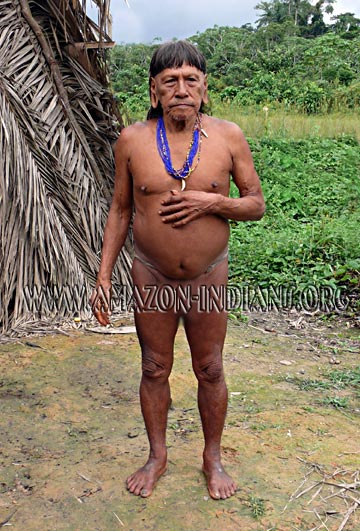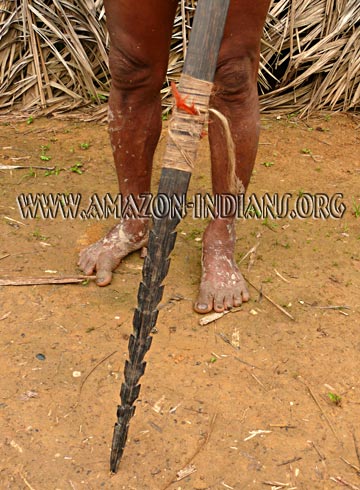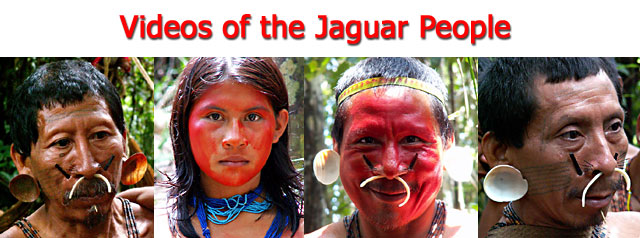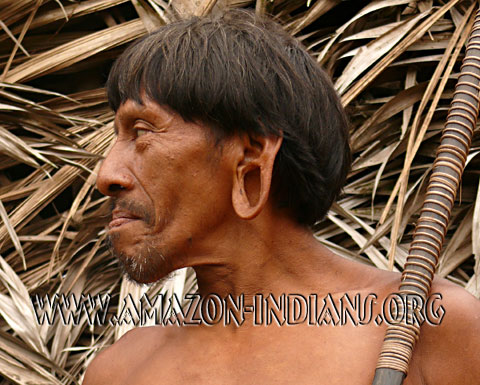n the Eastern part of Ecuador stretches el Oriente, the jungle. Between
the Napo and Curaray Rivers are 600,000 hectares of land that is the home of the
Huaorani, feared warriors of the Amazon Rainforest. This territory includes Yasuni National Park, one of the most bio-diverse places on the planet.
Unfortunate for the Huaorani, it also includes hundreds of kilometers of oil pipes and several oil company stations
that are having a devasting effect on this fragile tropical ecosystem.
The Huaorani are also known as Waorani, or Aucas. In Kichwa (the language spoken by the largest indigenous group of Ecuador)
“Auca” means “savage.” To the Huaorani, this is a derogatory term and
therefore, should not be used.
In Huao Terero (Wao Terero), the native tongue of the Huaoranis, “Huaorani” means “the people.”
Huao Terero is a language isolate, meaning it does not belong to any other linguistic family.
Due to encroachment on their territory by outsiders, there are fewer than 2,000
Huaoranis left today.
 The
Huaorani were contacted only 50 years ago. Before that time, these hunter-gatherers were roaming in small groups on an
area three times bigger than their present day territory. Recently, the Ecuadorian government granted the
Huaorani communal rights over their current territory. However, the government maintains ownership of the minerals and oil that lie beneath; thus the
Huaoranis do not fully own their land, a situation similar to the
Matses Indians living in Peru. The
Huaorani were contacted only 50 years ago. Before that time, these hunter-gatherers were roaming in small groups on an
area three times bigger than their present day territory. Recently, the Ecuadorian government granted the
Huaorani communal rights over their current territory. However, the government maintains ownership of the minerals and oil that lie beneath; thus the
Huaoranis do not fully own their land, a situation similar to the
Matses Indians living in Peru.
The Huaorani are not tall, but they have impressively strong bodies. With thick calves, buff torso, and sturdy hands, they are a pack of muscles. They hunt with
cerbatanas (blowguns) and spears, both 2.5 to 3 meters long, and very heavy, made of
chonta wood. The cerbatanas are built using a process similar to the
Yaguas Indians. Besides the
cerbatana, their hunting kit includes a round, hard fruit carcass filled with natural cotton, and a tube filled with thin, long, curare-dipped darts. Curare is a poisonous concoction made by boiling a mix of vines and plants. It paralyzes,
and even kills the victim. The dart tube and the cotton-holder are tied together with rope spun of
chambira fibers, and worn across the back. A piranha jaw is also tied to the kit, and it is used to make a small dent around the tip of the dart, so when the dart penetrates the victim’s body it breaks, leaving the tip inside. Before inserting the dart in the cerbatana, cotton is rolled at the blunt end, making it stay in the cerbatana tube and helping it gain speed, when blown.
Being primarily hunters, the Huaorani diet consists mainly of meat (monkey, wild boar, turtles,
and tapir) but they also subsist on a few vegetarian items such as plantains, bananas,
cassava, and forest fruits.
 The
Huaorani are known for their spears, which are long, with both ends sharpened. One of the ends is carved with sharp
barbs. Once the spear enters the body, there is no way of taking it out without
tearing the flesh and causing more damage. They are feared by neighboring
tribes for their violent reputation. Huaoranis are indeed very temperamental, moody, and unpredictable. They have a long history of bloody vengeances; violent payback was part of their culture. Most of the conflicts were solved by spearing the other party, then the family of the victim would seek revenge,
thus perpetuating the vicious cycle. The
Huaorani are known for their spears, which are long, with both ends sharpened. One of the ends is carved with sharp
barbs. Once the spear enters the body, there is no way of taking it out without
tearing the flesh and causing more damage. They are feared by neighboring
tribes for their violent reputation. Huaoranis are indeed very temperamental, moody, and unpredictable. They have a long history of bloody vengeances; violent payback was part of their culture. Most of the conflicts were solved by spearing the other party, then the family of the victim would seek revenge,
thus perpetuating the vicious cycle.
In 1956 the Huaorani were contacted by missionaries of the Summer Language Institute and the process of evangelization began. The missionaries translated the Bible in
Huao Terero. They taught the
Huaorani it was shameful to walk around naked as they were accustomed, making them ashamed of their traditions and lifestyle.
The influence of missionaries became very apparent to me when I was playing cards with young adults in a Kichwa community in the jungle just outside
Huaorani territory. I was accompanied by a young Huaorani man who had been my guide in a trip
to
Huaorani territory. To make the game more entertaining, I proposed that whoever loses, get punished (made to do something funny, like sing, dance, or act silly). My guide immediately let me know that he was not allowed to dance, because in the Bible it is written that dancing is bad. When he was punished,
my Huaorani guide started singing a religious hymn learned from missionaries.
Huaoranis were lured to live in fixed areas (reservations) where the missionaries built houses and schools, thus destroying their nomadic lifestyle, and
disrupting their social structure. The missionaries paved the way for oil companies to enter
Huaorani territory and start drilling. Money, clothing, and new diseases made the
Huaorani dependent on consumer goods and western medicines. In exchange
for salt, sugar, and Nike shoes, they gave missionaries and oil companies permission to do pretty much whatever they wanted on their land.
 Some communities live close to
the oil company camps and the outside world, and consequently have suffered more
cultural degradation than those that live in more isolated areas. In these more
accessable communities, there is typically much alcohol abuse and violence, and the indigenous
people living there have become more materialistic, seeking luxuries such as stereos,
modern houses, and televisions. However, there still exist a few communities located deep in the jungle,
near the frontier with Peru, where people walk around naked, hunt with cerbatanas and spears, live in traditional houses, do not drink alcohol (even despising its use) and barely speak any Spanish. Some communities live close to
the oil company camps and the outside world, and consequently have suffered more
cultural degradation than those that live in more isolated areas. In these more
accessable communities, there is typically much alcohol abuse and violence, and the indigenous
people living there have become more materialistic, seeking luxuries such as stereos,
modern houses, and televisions. However, there still exist a few communities located deep in the jungle,
near the frontier with Peru, where people walk around naked, hunt with cerbatanas and spears, live in traditional houses, do not drink alcohol (even despising its use) and barely speak any Spanish.
One of the biggest challenges the Huaorani face are the oil companies, las petroleras. Their territory is very rich in oil
with Ecuador being the fifth largest oil exporter in South America. The oil companies built
the Via Auca, a 150 km road slashing through the heart of Huaorani territory. The problems that come with such a road are many, and of harsh consequences: deforestation, pollution, habitat
degradation, and invasion by settlers, the military, and oil company workers.
While some Huaorani have resisted the petroleras, others have become dependent
on them, some even becoming oil company employees.
The Huaoranis are feared by many people in the region, and even saying their name
often inspires fear and awe. But once you get to know them, you can see beyond their fearsomeness. They are happy, very talkative and cheerful. The women and men are equal,
in contrast to their neighbors, the Kichwas, where women are regarded (or at least treated) as inferior to men.
Huaorani men and women have different chores, but in family decision making, they are equal.
Huaorani women are very strong and independent, and I have even met a few
Huaorani men that were left by their wives. This never happens in Kichwa communities.
Another difference between the Huaorani and neighboring tribes is their low
fecundity. Whereas many Kichwas have between nine and twelve children, the
Huaoranis usually only have two or three. I once asked some Huaoranis why this difference, and they told me there were not enough resources to raise
that many kids. Huaorani women know how to make teas from tree bark, fruits and leaves, which act
as a natural birth control method.
Huaoranis create some superb handcrafts. They use achiote, a round, spiny fruit whose crushed seeds ooze a bright red juice, to paint natural fibers and their body for different occasions.
Both men and women fabricate gorgeous collars using seeds, wild boar teeth, and parrot feathers.
The Kome is the name for the traditional Huaorani clothing which consists
of a string wrapped around the waist that men use to tie their foreskins. The typical
Huaorani hairstyle is long hair in the back, with short bangs that go behind the ears. Elders have pierced ears, with the earlobes hanging down like looped rings.
These large pierced earlobes are a Huaorani trademark. Younger generations have stopped piercing,
as it is a very painful process; even brave warriors complained about the pain they had to go through in their childhood having their ears
pierced in this manner.
 A typical
Huaorani house is very tall, measuring ten meters in length by five meters in width. Men build the houses by first creating a semi elliptic frame out of flexible poles deeply rooted in the ground. Parallel with the floor, they tie more poles on which later on they place two layers of leaves in such a way that rain does not get in. These big shelters are dark, refreshing, and comfortable. Usually more than one family lives in a house,
and typically, a couple lives with their children and the parents of the husband. Nowadays, more
Huaoranis build their houses smaller, and only one couple with their children
lives in the house. Along the walls there are hammocks woven by the female
occupants of the house. These are the beds where everybody sleeps. There are
usually two or three fireplaces on the ground as well. Strings are tied in between the sustaining poles, to hang hunting tools, baskets, clothes, and
other items. A typical
Huaorani house is very tall, measuring ten meters in length by five meters in width. Men build the houses by first creating a semi elliptic frame out of flexible poles deeply rooted in the ground. Parallel with the floor, they tie more poles on which later on they place two layers of leaves in such a way that rain does not get in. These big shelters are dark, refreshing, and comfortable. Usually more than one family lives in a house,
and typically, a couple lives with their children and the parents of the husband. Nowadays, more
Huaoranis build their houses smaller, and only one couple with their children
lives in the house. Along the walls there are hammocks woven by the female
occupants of the house. These are the beds where everybody sleeps. There are
usually two or three fireplaces on the ground as well. Strings are tied in between the sustaining poles, to hang hunting tools, baskets, clothes, and
other items.
The Huaorani believe that when someone dies, the soul starts a journey towards heaven. On the way, in the middle of the path, a big anaconda is obstructing the way. Only brave souls can jump the boa and reach heaven. Whoever fails, returns to earth as a termite, and leads a miserable existence.
Time is still an ambiguous dimension for the majority of the Huaorani. “How old are you” is a completely irrelevant question,
as nobody really knows their age, except the younger Huaorani, that live closer to civilization and go to school.
The jaguar is revered and called “tigre.” The Huaorani identify closely with this majestic animal. Some elderly warriors are believed to have special powers and are able to transform themselves into jaguar. I met the chief of a village, an old and revered warrior. I was told he “had tiger” (tiene tigre). I thought he really had a pet in his house. It actually meant he had the power of transforming himself into the animal, and
to roam the jungle, communicating with the animals.
Sidenote:
Inside the Huaorani territory, between Shiripuno and Curaray Rivers there is the
Zona Intangible (the Off-Limit Zone), an area inhabited by two indigenous
groups that refuse any contact with the outside world, and choose to live in
complete isolation. They are the Tagaeri and Taromenane. It is
believed they number less than 150, and have never been contacted by the outside
world. The few attempts made to contact them have failed, with the
encounters ending up with the death of the intruders (missionaries, illegal
lodgers and oil company workers). This area is declared “intangible” even by the Ecuadorian government itself,
as it is thought that trespassers will not make it out alive if they are seen by the natives.
It is said that whoever does not respect their wish of seclusion, pays the price with their life. Even the
Huaoranis respect the forbidden area. Some have hypothesized that the Tagaeri and Taromenane are branches of
the Huaorani that separated from the main group a generation ago, right at the time of
the Huaorani's first contact with the outer world.

|


 The
Huaorani were contacted only 50 years ago. Before that time, these hunter-gatherers were roaming in small groups on an
area three times bigger than their present day territory. Recently, the Ecuadorian government granted the
Huaorani communal rights over their current territory. However, the government maintains ownership of the minerals and oil that lie beneath; thus the
Huaoranis do not fully own their land, a situation similar to the
The
Huaorani were contacted only 50 years ago. Before that time, these hunter-gatherers were roaming in small groups on an
area three times bigger than their present day territory. Recently, the Ecuadorian government granted the
Huaorani communal rights over their current territory. However, the government maintains ownership of the minerals and oil that lie beneath; thus the
Huaoranis do not fully own their land, a situation similar to the
 The
Huaorani are known for their spears, which are long, with both ends sharpened. One of the ends is carved with sharp
barbs. Once the spear enters the body, there is no way of taking it out without
tearing the flesh and causing more damage. They are feared by neighboring
tribes for their violent reputation. Huaoranis are indeed very temperamental, moody, and unpredictable. They have a long history of bloody vengeances; violent payback was part of their culture. Most of the conflicts were solved by spearing the other party, then the family of the victim would seek revenge,
thus perpetuating the vicious cycle.
The
Huaorani are known for their spears, which are long, with both ends sharpened. One of the ends is carved with sharp
barbs. Once the spear enters the body, there is no way of taking it out without
tearing the flesh and causing more damage. They are feared by neighboring
tribes for their violent reputation. Huaoranis are indeed very temperamental, moody, and unpredictable. They have a long history of bloody vengeances; violent payback was part of their culture. Most of the conflicts were solved by spearing the other party, then the family of the victim would seek revenge,
thus perpetuating the vicious cycle.
 Some communities live close to
the oil company camps and the outside world, and consequently have suffered more
cultural degradation than those that live in more isolated areas. In these more
accessable communities, there is typically much alcohol abuse and violence, and the indigenous
people living there have become more materialistic, seeking luxuries such as stereos,
modern houses, and televisions. However, there still exist a few communities located deep in the jungle,
near the frontier with Peru, where people walk around naked, hunt with cerbatanas and spears, live in traditional houses, do not drink alcohol (even despising its use) and barely speak any Spanish.
Some communities live close to
the oil company camps and the outside world, and consequently have suffered more
cultural degradation than those that live in more isolated areas. In these more
accessable communities, there is typically much alcohol abuse and violence, and the indigenous
people living there have become more materialistic, seeking luxuries such as stereos,
modern houses, and televisions. However, there still exist a few communities located deep in the jungle,
near the frontier with Peru, where people walk around naked, hunt with cerbatanas and spears, live in traditional houses, do not drink alcohol (even despising its use) and barely speak any Spanish.
 A typical
Huaorani house is very tall, measuring ten meters in length by five meters in width. Men build the houses by first creating a semi elliptic frame out of flexible poles deeply rooted in the ground. Parallel with the floor, they tie more poles on which later on they place two layers of leaves in such a way that rain does not get in. These big shelters are dark, refreshing, and comfortable. Usually more than one family lives in a house,
and typically, a couple lives with their children and the parents of the husband. Nowadays, more
Huaoranis build their houses smaller, and only one couple with their children
lives in the house. Along the walls there are hammocks woven by the female
occupants of the house. These are the beds where everybody sleeps. There are
usually two or three fireplaces on the ground as well. Strings are tied in between the sustaining poles, to hang hunting tools, baskets, clothes, and
other items.
A typical
Huaorani house is very tall, measuring ten meters in length by five meters in width. Men build the houses by first creating a semi elliptic frame out of flexible poles deeply rooted in the ground. Parallel with the floor, they tie more poles on which later on they place two layers of leaves in such a way that rain does not get in. These big shelters are dark, refreshing, and comfortable. Usually more than one family lives in a house,
and typically, a couple lives with their children and the parents of the husband. Nowadays, more
Huaoranis build their houses smaller, and only one couple with their children
lives in the house. Along the walls there are hammocks woven by the female
occupants of the house. These are the beds where everybody sleeps. There are
usually two or three fireplaces on the ground as well. Strings are tied in between the sustaining poles, to hang hunting tools, baskets, clothes, and
other items.
